Items filtered by date: July 2024
Causes of Burning Feet While Running
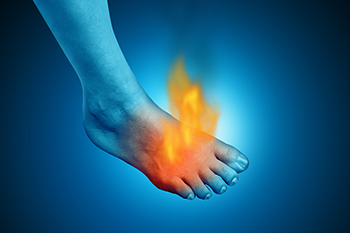
Experiencing a burning sensation in your feet while running can be painful and disrupt your fitness routine. This common issue can arise from overuse of foot muscles, iwearing mproper footwear, and friction. Running on hot surfaces and excessive sweating are other factors for burning feet. Overworking your foot muscles without adequate rest can lead to fatigue and a burning sensation. Friction from poorly fitting shoes or socks can irritate the skin while running on hot surfaces can directly cause a burning feeling. Excessive sweating creates a moist environment that can irritate the skin further. Addressing these issues through wearing proper footwear, moisture-wicking socks, and adequate rest can help alleviate symptoms. However, if the burning persists, it might indicate a more serious underlying condition such as nerve damage, diabetes, or hypothyroidism. If your feet feel like your feet are burning during a run, it is suggested that you schedule an appointment with a podiatrist.
Exercising your feet regularly with the proper foot wear is a great way to prevent injuries. If you have any concerns about your feet, contact Dr. John Branwell of Kearny, New Jersey. Our doctor will treat your foot and ankle needs.
How to Prevent Running Injuries
Many common running injuries are caused by overuse and overtraining. When the back of the kneecap starts wearing out and starts causing pain in your knee, this is commonly referred to as runner’s knee. Runner’s knee is a decrease in strength in your quadriceps and can occur if you’re not wearing properly fitted or supporting shoes. To prevent runner’s knee, focusing on hip strengthening is a good idea, as well as strengthening your quads to keep the kneecaps aligned.
What Are Some Causes of Running Injuries?
- One cause of a common running injury is called iliotibial band syndrome.
- Plantar fasciitis is also another common injury.
- Stress fractures can occur from overtraining, lack of calcium, or even your running style.
Best Ways to Prevent Running Injuries
- Wear footwear that fits properly and suits your running needs.
- Running shoes are the only protective gear that runners have to safeguard them from injury.
- Make a training schedule. Adding strengthening exercises as well as regular stretching can help keep you strong and limber and can lessen the possibility of injuries.
- Stretching keeps muscles limber; this will help you gain better flexibility.
If you have any questions please feel free to contact our office located in Kearny, NJ . We offer the newest diagnostic and treatment technologies for all your foot and ankle needs.
Essential Foot Exercises for Strength and Flexibility
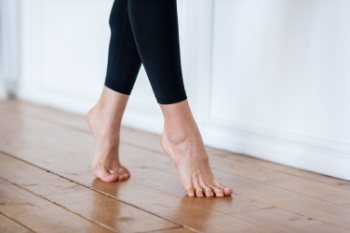
Incorporating foot exercises into your routine can enhance strength and flexibility. Isometric ankle opposition involves pressing the foot against a fixed object to build ankle strength without movement. The ankle alphabet exercise, where you trace the letters of the alphabet with your foot, improves range of motion and coordination. Simple leg balance, standing on one leg, enhances stability and proprioception, reducing the risk of falls and injuries. Additionally, the towel scrunch exercise, where you use your toes to scrunch up a towel on the floor, strengthens the muscles in the feet and toes. Regularly performing these exercises can help maintain foot health, prevent injuries, and improve overall balance and stability. Having strong feet and ankles may help to prevent injuries. If you have developed a foot condition as a result of having weak feet and ankles, it is suggested that you consult a podiatrist who can offer effective treatment remedies.
Exercising your feet regularly with the proper foot wear is a great way to prevent injuries and build strength. If you have any concerns about your feet, contact Dr. John Branwell from Kearny, New Jersey. Our doctor can provide the care you need to keep you pain-free and on your feet.
Exercise for Your Feet
Exercise for your feet can help you gain strength, mobility and flexibility in your feet. They say that strengthening your feet can be just as rewarding as strengthening another part of the body. Your feet are very important, and we often forget about them in our daily tasks. But it is because of our feet that are we able to get going and do what we need to. For those of us fortunate enough to not have any foot problems, it is an important gesture to take care of them to ensure good health in the long run.
Some foot health exercises can include ankle pumps, tip-toeing, toe rises, lifting off the floor doing reps and sets, and flexing the toes. It is best to speak with Our doctor to determine an appropriate regimen for your needs. Everyone’s needs and bodies are different, and the activities required to maintain strength in the feet vary from individual to individual.
Once you get into a routine of doing regular exercise, you may notice a difference in your feet and how strong they may become.
If you have any questions please feel free to contact our office located in Kearny, NJ . We offer the newest diagnostic and treatment technologies for all your foot and ankle needs.
Effective Stretches and Exercises for Plantar Fasciitis Relief
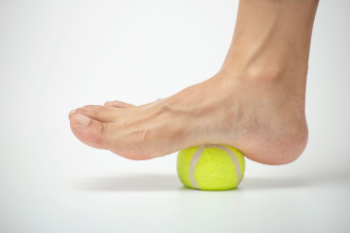
Plantar fasciitis, a common cause of heel pain, can be alleviated through specific stretches and exercises designed to strengthen and relax the plantar fascia. One effective stretch is the calf stretch, performed by leaning against a wall with one leg extended back and the other bent forward, ensuring both heels are on the ground. This stretch targets the calf muscles and Achilles tendon, providing relief. The towel stretch involves sitting with legs extended, looping a towel around the toes, and gently pulling them towards the body to stretch the bottom of the foot. Rolling a tennis ball or a frozen water bottle under the foot can massage the plantar fascia and reduce tension. Additionally, toe curls and picking up marbles with the toes can strengthen the muscles in the foot. If you have heel pain, it is suggested that you visit a podiatrist who can accurately diagnose plantar fasciitis, and stress how specific stretches may help to provide relief.
Plantar fasciitis can be very painful and inconvenient. If you are experiencing heel pain or symptoms of plantar fasciitis, contact Dr. John Branwell from Kearny, New Jersey. Our doctor can provide the care you need to keep you pain-free and on your feet.
What Is Plantar Fasciitis?
Plantar fasciitis is the inflammation of the thick band of tissue that runs along the bottom of your foot, known as the plantar fascia, and causes mild to severe heel pain.
What Causes Plantar Fasciitis?
- Excessive running
- Non-supportive shoes
- Overpronation
- Repeated stretching and tearing of the plantar fascia
How Can It Be Treated?
- Conservative measures – anti-inflammatories, ice packs, stretching exercises, physical therapy, orthotic devices
- Shockwave therapy – sound waves are sent to the affected area to facilitate healing and are usually used for chronic cases of plantar fasciitis
- Surgery – usually only used as a last resort when all else fails. The plantar fascia can be surgically detached from the heel
While very treatable, plantar fasciitis is definitely not something that should be ignored. Especially in severe cases, speaking to your doctor right away is highly recommended to avoid complications and severe heel pain. Your podiatrist can work with you to provide the appropriate treatment options tailored to your condition.
If you have any questions please feel free to contact our office located in Kearny, NJ . We offer the newest diagnostic and treatment technologies for all your foot and ankle needs.
Are Bunions Affecting Your Everyday Life?
What to Do About Heel Pain
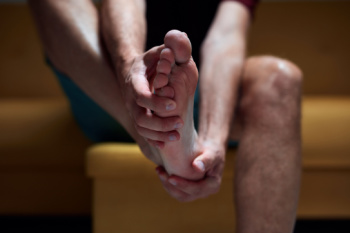 Heel pain, often linked to conditions such as plantar fasciitis, is a prevalent complaint that affects the bottom or back of the heel. This pain typically results from inflammation, overuse, or injury to the plantar fascia, a thick band of tissue that supports the arch of the foot. Factors contributing to heel pain include excessive walking or standing, wearing improper footwear, obesity, and age-related changes. The pain is usually sharp and most intense during the first steps in the morning or after long periods of rest. It can significantly interfere with daily activities, making walking, exercising, and even standing difficult. Diagnosis involves a physical examination, patient history, and sometimes imaging tests like X-rays or MRI scans to rule out fractures or other issues. Treatment typically includes rest, anti-inflammatory medications, and stretching exercises. Custom orthotics and targeted stretching exercises may also be recommended. If you have persistent or severe heel pain, it is suggested that you schedule an appointment with a podiatrist for specialized care and treatment.
Heel pain, often linked to conditions such as plantar fasciitis, is a prevalent complaint that affects the bottom or back of the heel. This pain typically results from inflammation, overuse, or injury to the plantar fascia, a thick band of tissue that supports the arch of the foot. Factors contributing to heel pain include excessive walking or standing, wearing improper footwear, obesity, and age-related changes. The pain is usually sharp and most intense during the first steps in the morning or after long periods of rest. It can significantly interfere with daily activities, making walking, exercising, and even standing difficult. Diagnosis involves a physical examination, patient history, and sometimes imaging tests like X-rays or MRI scans to rule out fractures or other issues. Treatment typically includes rest, anti-inflammatory medications, and stretching exercises. Custom orthotics and targeted stretching exercises may also be recommended. If you have persistent or severe heel pain, it is suggested that you schedule an appointment with a podiatrist for specialized care and treatment.
Many people suffer from bouts of heel pain. For more information, contact Dr. John Branwell of Kearny, New Jersey. Our doctor can provide the care you need to keep you pain-free and on your feet.
Causes of Heel Pain
Heel pain is often associated with plantar fasciitis. The plantar fascia is a band of tissues that extends along the bottom of the foot. A rip or tear in this ligament can cause inflammation of the tissue.
Achilles tendonitis is another cause of heel pain. Inflammation of the Achilles tendon will cause pain from fractures and muscle tearing. Lack of flexibility is also another symptom.
Heel spurs are another cause of pain. When the tissues of the plantar fascia undergo a great deal of stress, it can lead to ligament separation from the heel bone, causing heel spurs.
Why Might Heel Pain Occur?
- Wearing ill-fitting shoes
- Wearing non-supportive shoes
- Weight change
- Excessive running
Treatments
Heel pain should be treated as soon as possible for immediate results. Keeping your feet in a stress-free environment will help. If you suffer from Achilles tendonitis or plantar fasciitis, applying ice will reduce the swelling. Stretching before an exercise like running will help the muscles. Using all these tips will help make heel pain a condition of the past.
If you have any questions please contact our office located in Kearny, NJ . We offer the newest diagnostic and treatment technologies for all your foot and ankle needs.
Causes and Diagnosis of Athlete's Foot
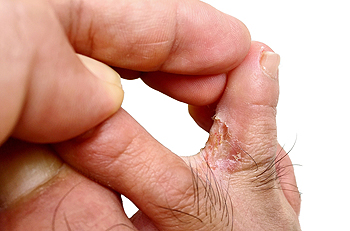
Athlete's foot, medically known as tinea pedis, is a fungal infection that affects the skin on the feet. It is causes itching, burning, and cracked, scaly skin, often occurring between the toes. The infection is caused by dermatophytes, fungi that thrive in warm, moist environments such as locker rooms, showers, and swimming pools. Athlete's foot spreads through direct contact with an infected person or by touching contaminated surfaces. Diagnosis typically involves a physical examination of the affected area by a podiatrist. In some cases, a skin scraping may be taken and examined under a microscope to confirm the presence of the fungus. Proper diagnosis is important to differentiate athlete's foot from other skin conditions. If you have any of the above symptoms, it is suggested that you consult a podiatrist who can effectively treat athlete’s foot, which may include prescribed medication.
Athlete’s foot is an inconvenient condition that can be easily reduced with the proper treatment. If you have any concerns about your feet and ankles, contact Dr. John Branwell from Kearny, New Jersey. Our doctor will treat your foot and ankle needs.
Athlete’s Foot: The Sole Story
Athlete's foot, also known as tinea pedis, can be an extremely contagious foot infection. It is commonly contracted in public changing areas and bathrooms, dormitory style living quarters, around locker rooms and public swimming pools, or anywhere your feet often come into contact with other people.
Solutions to Combat Athlete’s Foot
- Hydrate your feet by using lotion
- Exfoliate
- Buff off nails
- Use of anti-fungal products
- Examine your feet and visit your doctor if any suspicious blisters or cuts develop
Athlete’s foot can cause many irritating symptoms such as dry and flaking skin, itching, and redness. Some more severe symptoms can include bleeding and cracked skin, intense itching and burning, and even pain when walking. In the worst cases, Athlete’s foot can cause blistering as well. Speak to your podiatrist for a better understanding of the different causes of Athlete’s foot, as well as help in determining which treatment options are best for you.
If you have any questions please feel free to contact our office located in Kearny, NJ . We offer the newest diagnostic and treatment technologies for all your foot and ankle needs.

